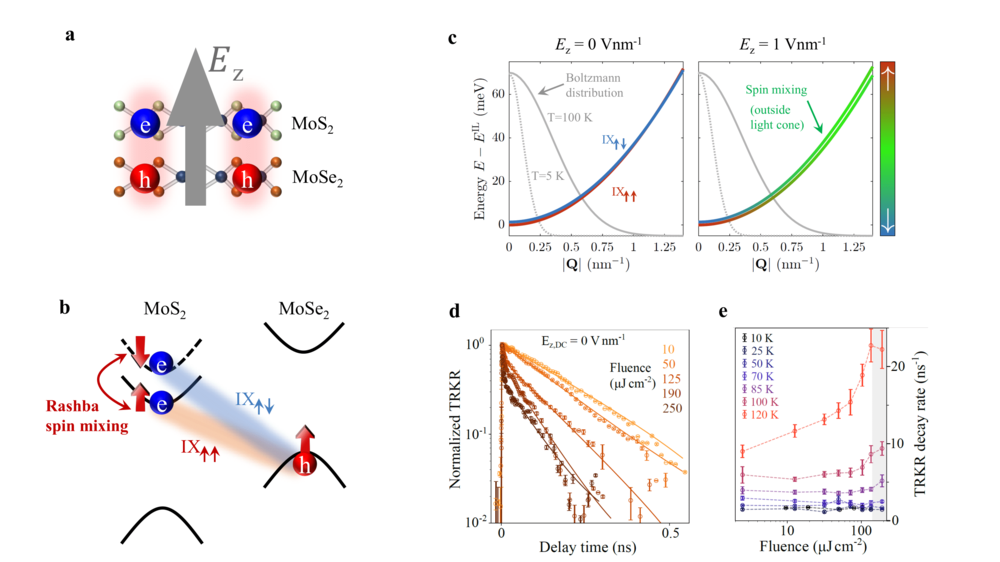New method to control ultrafast spin dynamics in 2D semiconductors - New TRR 227 paper published in Phys. Rev. Lett.
Researchers from FU Berlin (projects B08 and B07) and collaborators from TU Berlin have discovered a new method to control ultrafast spin dynamics in 2D semiconductors. This breakthrough reveals an intricate coupling between spin and momentum of excitons via the Rashba effect with optically controlled magnitude. This effect plays a critical role in defining spin dynamics in 2D semiconductors.
News from Jan 17, 2025
Figure caption:
(a) Cartoon of a MoS2/MoSe2 heterostructure. Electrons and holes are layer-separated, inducing an out-of-plane electric field, Ez. (b) Band schematic with two lowest energy interlayer excitons with electrons residing in the spin-split conduction bands of MoS2. Rashba interaction (red arrow) mixes the two electron spins. (c) Theory calculations for interlayer exciton dispersion with zero Ez (left) and Ez = 1Vnm-1 (right). Momentum-dependent spin mixing is observed at nonzero electric field. (d) TRKR dynamics vs. pump fluence (experiments) associated with the interlayer excitons. The spin/valley relaxation rate increases with the fluence. (e) Temperature-dependent TRKR decay rate vs. pump fluence. The fluence dependence becomes pronounced above T = 70 K, confirming phonon-assisted Rashba interactions. The gray coloring denotes fluence range where the excitonic physics enters nonlinear regime.
Controlling spin-orbit interactions is crucial to realize ultrafast spin manipulation in spintronic devices. Two-dimensional (2D) semiconductors based on transition metal dichalcogenides (TMDs) are promising spintronic materials due to strong spin-orbit interactions and spin/valley locking. In these materials, an optical excitation creates excitons---Coulomb-bound electron-hole pairs---that carry the spin/valley information.
When two monolayers of TMDs are stacked vertically, new interlayer excitons with an out-of-plane dipole are formed. Therefore, such heterostructures experience a self-induced electric field, which is predicted to modify the spin/orbit interactions via the Rashba mechanism. However, the understanding of this fundamental spin relaxation mechanism in TMDs has remained elusive.
The FU Berlin team (leading PIs: Kirill Bolotin, Cornelius Gahl) collaborated with the theorists from TU Berlin (Andreas Knorr, Henry Mittenzwey and Malte Selig), who developed a microscopic theory describing the Rashba-induced spin relaxation mechanism for the interlayer excitons in a MoS2/MoSe2 heterostructure. The experimentalists (led by Abhijeet Kumar, Raghav Dhingra) successfully confirmed those theoretical predictions by employing time-resolved Kerr-rotation (TRKR) microscopy and by controlling the electric field in their devices.
The key aspect of this work is the simplicity of the approach to controlling spin relaxation. The researchers demonstrated that the rate of Rashba relaxation can be controlled by an order of magnitude simply by controlling the incident optical power. Moreover, presented results reveal that the phonon-assisted Rashba interactions dominate the spin relaxation dynamics of interlayer excitons at temperatures above 70 K. Overall, this pioneering work offers a powerful new tool for ultrafast spin manipulation in 2D semiconductors and suggests new spintronic applications of these materials.
This research article was recently published in Physical Review Letters (PRL).
https://doi.org/10.1103/PhysRevLett.134.026901
H. Mittenzwey*, A. M. Kumar*, R. Dhingra, K. Watanabe, T. Taniguchi, C. Gahl, K. I. Bolotin, M. Selig, and A. Knorr
*Contributed equally.

